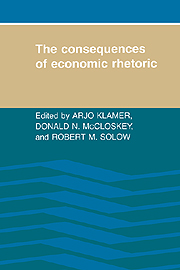Book contents
- Frontmatter
- Contents
- Preface
- The consequences of economic rhetoric
- PART I ECONOMIC RHETORIC: INTRODUCTION AND COMMENTS
- PART II ECONOMIC RHETORIC: FURTHER ARGUMENTS
- PART III ECONOMIC RHETORIC AMONG ECONOMISTS
- 9 Shall I compare thee to a Minkowski–Ricardo–Leontief–Metzler matrix of the Mosak–Hicks type? Or, rhetoric, mathematics, and the nature of neoclassical economic theory
- 10 On the brittleness of the orange equilibrium
- 11 The significance of significance: Rhetorical aspects of statistical hypothesis testing in economics
- 12 The rhetoric of self-interest: Ideology of gender in economic theory
- PART IV ECONOMIC RHETORIC IN POLITICS AND JOURNALISM
- PART V ECONOMIC RHETORIC: ITS RHETORIC AND ITS CONSEQUENCES
- 1 Appendix: Other contributors and participants
- Index
11 - The significance of significance: Rhetorical aspects of statistical hypothesis testing in economics
Published online by Cambridge University Press: 07 September 2010
- Frontmatter
- Contents
- Preface
- The consequences of economic rhetoric
- PART I ECONOMIC RHETORIC: INTRODUCTION AND COMMENTS
- PART II ECONOMIC RHETORIC: FURTHER ARGUMENTS
- PART III ECONOMIC RHETORIC AMONG ECONOMISTS
- 9 Shall I compare thee to a Minkowski–Ricardo–Leontief–Metzler matrix of the Mosak–Hicks type? Or, rhetoric, mathematics, and the nature of neoclassical economic theory
- 10 On the brittleness of the orange equilibrium
- 11 The significance of significance: Rhetorical aspects of statistical hypothesis testing in economics
- 12 The rhetoric of self-interest: Ideology of gender in economic theory
- PART IV ECONOMIC RHETORIC IN POLITICS AND JOURNALISM
- PART V ECONOMIC RHETORIC: ITS RHETORIC AND ITS CONSEQUENCES
- 1 Appendix: Other contributors and participants
- Index
Summary
Introduction
It may not be immediately evident that statistical hypothesis testing is a proper subject for attention in this volume. The formal testing of hypotheses is a branch of statistics, based on axioms of probability and the strict rules of mathematical logic. Journals in statistics, as well as in biometrics, econometrics, and other statistically oriented disciplines, are full of highly technical articles on the theory of hypothesis testing, emphasizing mathematical rigor and logical precision. Surely statistical hypothesis testing has little if anything to do with the rhetoric of economics.
So it may appear at first glance. But let us take a second one. The abstract framework of hypothesis testing provides a set of input boxes and a logical structure for drawing inferences once the boxes have been filled. The boxes have names like Null Hypothesis, Data, and Assumed Sampling Distribution. In applications in economics these boxes are filled by economists who seek to use the testing framework to provide evidence about regularities in economic life. Most of the data that economists use are perforce nonexperimental, and the framework therefore requires special interpretation. So interpreted, it takes on a particular metaphorical content: A story must be told (or accepted implicitly) so that the data can be treated as if they were a sample from an unseen (and unseeable) parent population or the product of an invisible generating mechanism that was capable of spewing out infinitely many 1986 GNP growth rates but in fact produced only one.
- Type
- Chapter
- Information
- The Consequences of Economic Rhetoric , pp. 163 - 183Publisher: Cambridge University PressPrint publication year: 1989
- 6
- Cited by



